what to do at san francisco when raining
San Francisco Weather
Why is information technology so cold!!?
Tips for visitors to our city
Hint...it's not Southern California.
The practiced news: San Francisco has a very mild climate. It rarely gets out of the 55 to 65 degree range (12 to 18°C), summer or winter.
There's no bad news! Just a reminder to visitors that it's oft absurd and windy, especially in the afternoon.
I want our guests to thoroughly enjoy their stay with u.s., which means not freezing on the Golden Gate Span when the fog comes in. No blue legs on the bridge!
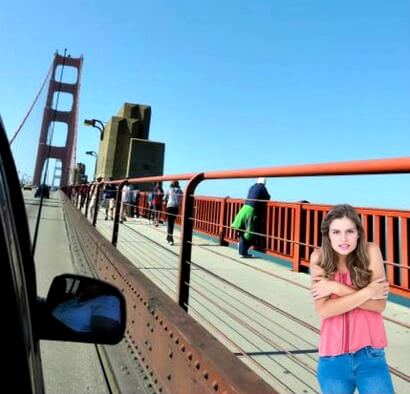
What we don't want to encounter.
Bay Expanse Microclimates
The Bay Area is unusual in the wide variety of climates that exist just within a few miles of each other. Even San Francisco, but vii miles square, has microclimates within its city limits.
This expanse is considered to have a Mediterranean climate: hot, dry summers and cool, rainy winters. And that is generally true. But San Francisco got left out of the hot, dry part, due to its position on the tip of a peninsula surrounded by very cold h2o.
San Francisco also benefits from the contrast between the cold ocean current and the extreme heat of California'south Central Valley. The outcome is a pretty steady onshore flow of cool air, pulled in past the stifling hot air inland which rises. This as well pulls the famous fog inland onto the city.

The fog typically shows upwardly offshore effectually 2:thirty to 3:00 pm. So it rolls in through the Aureate Gate, across the bay and sometimes up into the Berkeley Hills.
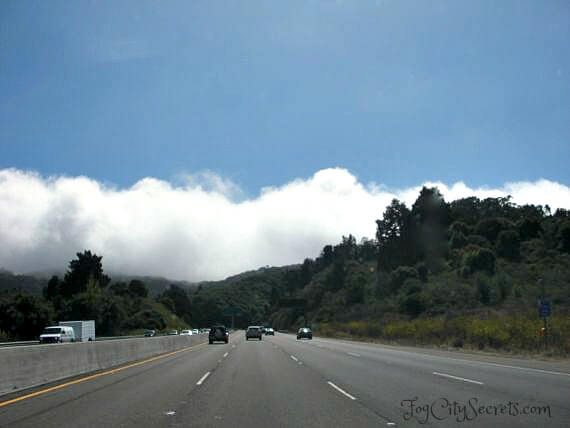
The Fog Coming In
View From North of the Bridge
When it flows onshore, it covers the western half of the city and gets caught up on the range of hills in the center of SF. As a result, the outer neighborhoods near the bounding main (the Sunset and Richmond districts) tend to be a lot foggier than the residuum of the city. The weather condition forecast for San Francisco comes in two parts: the littoral surface area and the rest.
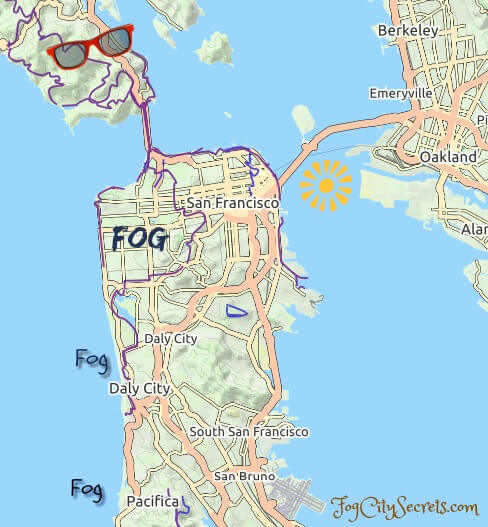
Bay Area Summer Weather
Sudden Changes
A sunny afternoon about the bridge tin can be cold and foggy an hour later. Hence our recommendation to wearing apparel in layers.
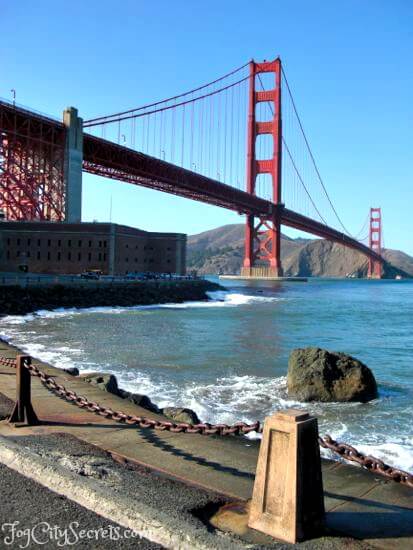
A Cute Afternoon
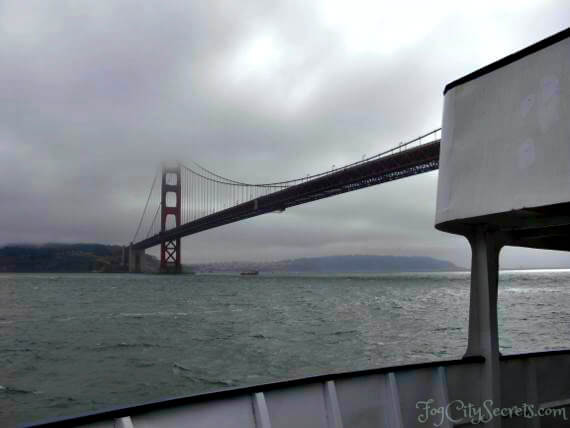
Foggy Ferry Ride
What About Rain?
Being that San Francisco has a quasi-Mediterranean climate, lxxx% of the rain falls in 5 months, November through March. April is iffy; ofttimes sunny and warm, but can become pelting. The entire residuum of the year, May through October, only gets virtually 5% of the annual rainfall.
Consequently, if you come when most people visit, May through October, your take a chance of having your holiday ruined by atmospheric precipitation is very low (so you don't have to carry an umbrella effectually).
Note: Fog season is May, June and July, and often August, only mainly out in the western part of SF.
What to Wear
Because the weather in San Francisco is so changeable, the best solution is to dress in layers. A jacket or sweatshirt with a hood is the all-time outer layer; the wind can be cold and strong when the fog starts to come in. Just an hour later, the fog may fire off and information technology'south getting warm, so a t-shirt or calorie-free long-sleeved shirt would be more than comfortable. Or the other fashion around. The hoodie vendors on Fisherman'due south Wharf do a brisk business! (I would ditch the shorts.)
Best Months for Weather in San Francisco
Where's the Sun?
The bay counties surrounding SF get very warm in summer, frequently really hot, and meet sunny skies every solar day, while San Francisco sits in its cool, foggy spot all summertime. But even within San Francisco in that location are noticeable differences in temperature and sun.
There can be a 10 caste difference between downtown San Francisco and the Avenues, out by the beach. The areas popular with tourists tend to be in the sunnier office, like Fisherman's Wharf and Matrimony Foursquare, but Aureate Gate Park, the zoo, the Cliff Business firm and Ocean Beach are often socked in May, June and July. The warmest and sunniest parts of the city? The Mission District and Potrero Hill on the eastern side, sheltered by the hills.
Is San Francisco the only foggy town in the Bay Area? No...Daly Urban center, just south of SF is worse; and the oceanside town of Pacifica, but minutes down Highway ane from San Francisco, is the foggiest of all.
Typical San Francisco Weather
The weather changes here in minutes. Nevertheless, there are some common patterns with the conditions in San Francisco.
A Typical Summertime Day in SF
June, July and Baronial tend to see a lot of fog. The classic pattern is fog on the declension in the morning, cool and mid to upper 50'due south (12 °C), burning off by around x am, sunny and low 60's (17 °C) until around 3 pm when the cool air current from the bounding main starts up, and the fog rolls dorsum in. Socked in until 5 or half dozen pm, when it clears upward again and the wind dies down. In the Avenues, the Sunset and Richmond Districts closest to the ocean, the fog can sit at that place all solar day.
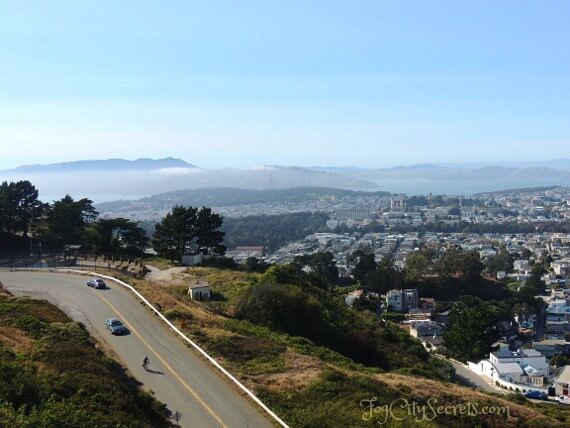
Afternoon Fog Rolls Through the Gilded Gate
View From Twin Peaks
A Typical Winter Day in SF
During our severe drought in California, we had a couple of gorgeous, warm and sunny winters, but the rain returned in the wintertime of 2015/2016. Since then, it'southward been off and on; the past winter (2018/2019) was stormy and wet.
In winter (November through February), temperatures usually hang out in the mid 50's (18 °C) in the daytime, and drop into the low fifty'south (11 °C) and upper 40'southward (9 °C) at night. Rain comes in waves; a storm will blow in, last for a couple of days, and then movement inland. A few days or weeks afterward, some other front comes in and repeats.
Even when nosotros do get rain, it but averages around one third of the days in the month, and then information technology's actually pretty tame in winter. Occasionally we become some fierce winds which knock downwardly trees, but nosotros rarely see those heavy downpours that people in other parts of the country get. Thunder and lightning are rare as well. Kind of tedious, conditions-wise!
Spring Weather
March, April and May show a transition from rain to fog, though April tin can exist gorgeous and sunny. May is one of our fog-jump months, with both day and night sitting at 58 degrees (xiv °C) and gray!
The All-time Time to Come to SF
Our warm and sunny months are September and October. The air is clear and golden and the urban center looks its best. Information technology tin fifty-fifty get hot (in the xc'south, 32 °C+! ), only that but lasts 2 or 3 days before our natural air-conditioning kicks in: offshore fog...yay. During our "heat waves", the fog stays manner offshore and at that place'due south not a cloud in the heaven.
All of the higher up is merely typical, not guaranteed!
Weather condition Odds and Ends
Earthquake Weather
If the day is hot and the air is very all the same, you may hear someone mention "earthquake weather". Fifty-fifty though at that place appears to be no scientific ground for a correlation, some people get a bit anxious when the day is unseasonably hot and our afternoon winds are a no-testify. The October day in 1989 when the last hefty earthquake struck was actually hot and windless, and the weather was unusually warm the day of the Big One in 1906, just don't allow it worry y'all! It's usually absurd and windy in SF.
Who is Karl the Fog?
Referring to the fog as Karl got started a few years back when someone created the hashtag #karlthefog on Twitter and information technology took off for some reason. Karl refers to Karl the giant in the film Big Fish; why, I don't know.
Speaking of Karl, Carl Sandburg'due south poem Fog captures its essence. He was talking about Chicago, but nosotros'll have information technology.
Fog
The fog comes
on trivial cat feet.
It sits looking over harbor and metropolis
on silent haunches
and then moves on.
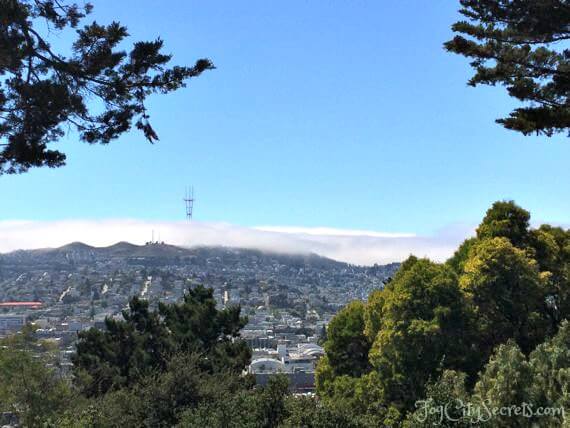
Fog on Twin Peaks
And here it is...the famous quote well-nigh San Francisco weather condition that Marker Twain never said:
"The coldest wintertime I ever spent was a summertime in San Francisco."
Actually, Marker Twain had a high opinion of our weather, but he suffered mightily from a cold and rainy summer he spent in Paris in 1879.
Dave Burkhart at Ballast Brewing Visitor researched this quotation and tracked it back to its original author. You lot can read his entertaining business relationship of information technology, along with Twain's funny weather remarks, at coldest winter.
More to explore...
- Home >
- San Francisco Weather
Scroll downwards for COVID updates.
COVID-19 Condition: at midnight on Monday, March xvi, San Francisco was placed under a "shelter-in-identify lodge.
All residents were ordered to stay dwelling house, except for necessary trips to grocery stores and essential medical visits, and solo outdoor activities similar hiking.
The metropolis was gradually reopening of many businesses and activities, but in Dec, came under a strict, stay-at-dwelling house directive, due to a sudden increase in infection and hospitalization rates.
Since then, Covid numbers had dropped significantly, simply recently started ascension again.
Big changes arrived June 15, 2021: California is "fully reopened", meaning all business sectors will reopen to total or nigh total capacity, including concerts, stadium sports and festivals. SF is basically open, though somewhat more cautious in some regards.
As of August 20, 2021, nearly eighty% of eligible SF residents have been fully vaccinated.
Vaccine requirements: Starting Baronial 20, 2021, SF requires that all restaurants, bars, theaters and gyms check for proof of full vaccination.
Documents accustomed: newspaper or digital vaccination records.
See SF Chron article re: vaccination.
Public transportation options had been cut back, just are expanding again. See SF transit for more than info.
The cable cars are running once again and are gratis during August! In September, they volition resume full (paid) service, starting with the Powell-Hyde Line, and the other two lines to follow after.
Meet COVID rules for electric current SF status.
Mask rules: another modify, starting August three, 2021. Everyone is now required to wear a mask indoors in SF, whether vaccinated or not. People may go without masks outdoors unless the expanse is densely populated. Hospitals, schools, nursing homes and public transit, still require masks./p>
What is open up? Muir Wood, the Botanic Gardens, Golden Gate Park, Japanese Tea Garden, Pier 39, SF beaches, Gilded Gate Bridge, and Twin Peaks (automobile access on Portola, main parking lot open up) are all open.
Parking lots for SF beaches, Twin Peaks, and the Aureate Gate Span are open, including the Welcome Center lot.
Restaurants can now be open up to full chapters for indoor and outdoor dining, and many restaurants are open for take-out or delivery.
Confined that serve food can serve customers indoors.
Businesses tin can allow customers inside, up to total capacity. Malls are open up.
The SF Zoo is open up once again.
Offices can reopen up to full capacity.
Alcatraz is open. The 24-hour interval Tours and Dark Tours are running on a somewhat reduced footing. The Cell Block is open besides. Encounter Alcatraz.
Hair salons, and open air tour buses, outdoor walking tours, and boat cruises can now operate.
Indoor museums are open up, including the CA Academy of Sciences.
Travel to SF. Per the California Dept. of Public Health: non-essential travel to SF from exterior California is discouraged simply the quarantine requirements are no longer in outcome.
Unvaccinated travelers are urged to get tested before and after arrival, and to self-quarantine for 7 days, but this isn't mandatory.
"Not-essential travel" basically means tourism.
Hotels are accepting reservations, simply travelers are urged to limit contact with others in the hotel.
Exploratorium: open.
Playgrounds: open.
Indoor swimming pools are open to fullcapacity.
Schools: individual schools are open. SF public schools started in-person learning for uncomplicated students April 12. Older grades: negotiations are ongoing. Hopefully all grade levels will be open up for in-person fall classes. Masks will be required for students in SF public schools in the fall.
Indoor gyms and indoor picture show theaters are open to full capacity.
Indoor concerts, live theater, and sporting events, may open up at total capacity. For indoor gatherings of >5,000, proof of vaccination will be required.
Outdoor events for >x,000: may require proof of vaccination or negative exam, merely aren't required to.
Check individual events for requirements.
Napa and Sonoma county wineries are open up.
For a handy list of what's open or closed, in California, see California reopening schedules.
See coronavirus news in the SF Chronicle for details and updates.
Also encounter site and parking lot closures for the National Park Service (Alcatraz, Muir Wood, etc.)
Plus helpful info on which parks and hiking trails are open in the Bay Expanse.
And to check the air quality (fires) in SF and the Bay Area, run into airnow.gov and the SF Relate map showing current tests.

Become the latest tips on visiting San Francisco.
SF Motorbus, BART, & Cable Car routes.
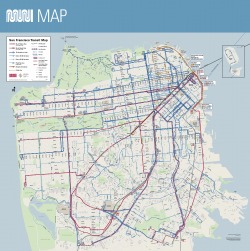
Muni Route Map

Become Alcatraz tickets.
edmondstoneinvuld.blogspot.com
Source: https://www.inside-guide-to-san-francisco-tourism.com/san-francisco-weather.html